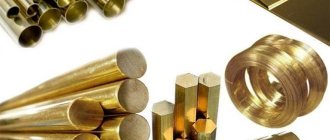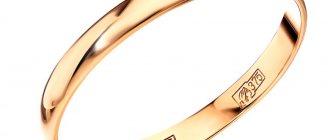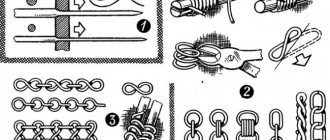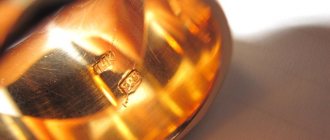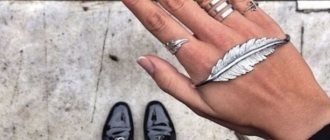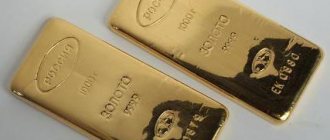Rare 900 standard silver and gold: composition, alloy properties and shade table
900 silver, like gold, is almost never used for jewelry purposes. These alloys themselves are quite ductile, are considered rare, and are used only for handmade work to order.
The density of 900 gold is 19.32 g/cm3. High-grade metal with a minimal amount of impurities is quickly scratched, chipped, deformed, loses its external shine and attractive appearance. The composition may have faint shades, which will vary depending on the proportion of each component of the alloy. The following color options are available:
| Metal color | Share of components, gr. | Share of components, gr. | Share of components, gr. |
| Gold | Silver | Copper | |
| Red | 900 | 10 | 90 |
| Yellow | 900 | 40 | 60 |
| White | 900 | 90 | 10 |
Applications of gold
In industry, the yellow precious metal is used to make ingots for the market system of states. Gold easily reflects sunlight and is polished. Tinted glass is made from yellow metal (used for skyscrapers). This significantly saves thermal energy. The precious metal also found use among astronauts. A small amount is added to a protective helmet to reflect the flow of infrared radiation in outer space.
It is often used in dental surgery for the manufacture of dental crowns and dentures, as it does not cause allergic reactions.
Gold is used to coat corrosive metals, manufacture household items, and in the electrical industry. The color of the metal and alloy changes under the influence of the substances that make up the alloy. Quantitative characteristics determine labeling and cost. 900 standard has 90 percent of only one gold. Metal melts at a temperature of 1063 degrees and boils at 2250 degrees.
Gold metal marked 900 is used in many countries around the world. In Russia, products made of precious metals with this designation are not officially stamped, but are marked with a 750 standard stamp.
In expensive, exquisite jewelry, 900 hallmark looks beautiful and prestigious. It is often bought up and sold abroad at a profit. Jewelry is stored for a long time and can be passed on to future offspring without financial investment.
In the 18th century in Russia, coins were minted with a similar alloy. Emperor Alexander III finally introduced the marking with the designation 900, which is still used today.
Jewelry 900 standard contains silver and copper. A rich yellow color is characteristic of products with a low copper content (1%). The bright yellow-red color of the alloy contains up to 9% copper.
In Russia, from 1798 until 1927, the spool marking was used for jewelry metal. The system was designed as follows: the sample was based on one pound containing 96 spools. For example, in 36 spools the mass of the precious metal was 0.375 of the weight of the alloy.
Use of 900 hallmark in precious metals
Despite its natural softness, 900 gold is used for the production of collectible coins and jewelry in certain countries of Asia and Europe. However, the shade of such items may differ, since different ligature ratios are used.
Jewelry items are massive in size and heavy in weight due to the increased softness of the alloy.
Dentistry
Until 1956, dentists used alloy 916. Afterwards, it was decided to use 900 sample, which was considered of higher quality. This composition was distinguished by greater strength and lower cost of prostheses. Metal is used to make crowns due to its hypoallergenic qualities.
900 gold tooth
Jewelry in Europe, China and the Far East
900 standard is partially equivalent to foreign quality standards, since it refers to 21.6 carats. This gold is sometimes used to make jewelry in Germany, China, India, Egypt, Thailand, and the UAE.
Making commemorative coins
During the times of Ancient Rus', high-grade gold was actively used to issue coins. Under Tsar Peter I, alloys from 781 to 980 could be used to make coins. Only under Queen Elizabeth, means of payment began to be made from precious metals mixed with 14% ligature.
What does the sample on the ring look like?
In everyday life, hallmark is usually called an assay mark, which is affixed to a piece of jewelry. It is applied to products not at enterprises and workshops, but in regional divisions of the State Assay Supervision Inspectorate.
Now let's see where the hallmark is placed on a gold or silver ring. The rules stipulate that the hallmark should not spoil the appearance of the product, therefore, on the ring it is usually placed on the inside of the shank (rim).
In Russia, state stamps on precious metals appeared somewhat later than in other European countries. For example, silver began to be hallmarked in 1613, and gold only in 1700.
The hallmark has changed greatly since its introduction. At the moment in Russia it consists of four mandatory elements:
- General outline. For example, the overall outline of a hallmark on a gold ring looks like a stylized spatula, on silver it looks like a barrel lying on its side, on platinum it looks like a rectangle with cut corners.
- A number reflecting the content of pure precious metal in the alloy. As we have already found out, in Russia this is a three-digit number. The lowest standard for gold is 385, for silver – 800.
- A generally accepted symbol. Previously, there was a five-pointed star in this place, but now it has been replaced by the profile of a girl in a kokoshnik, looking to the right.
- Letter code of the State Inspectorate. To the left of the girl’s head there is a letter indicating the code of the specific inspection of the State Assay Supervision, where the product was checked.
Two hallmarks on a ring mean that you are slightly confused: in addition to the hallmark, a name tag must be affixed to the jewelry piece. These are four letters from which you can read a brief history of the decoration.
The first letter of the name is the digital designation of the year of manufacture of the product (starting with A - 2001), the second is the inspection code where the inspection and testing is carried out, the third and fourth are the code of a specific manufacturer, individual within the framework of a specific inspection.
Not only large enterprises, but also private jewelers have personal stamps of their namesakes. They are required to place individual marks on products before sending them to the assay authorities.
Where and how can you buy 900 gold
Today metal 900 is actively used for making souvenir coins. Thus, Sberbank offers a large selection of different coin symbols dedicated to different world dates and events. One of the most popular “Orthodox Saints” series, minted by the Polish Mint. Each such symbol weighs 8 grams and contains images of saints. You can buy them at any branch of a financial institution.
Also, 900 standard can be found in pawn shops or other institutions that accept precious scrap and jewelry. Here this precious brand is represented by imported products, the price is much lower than ordering from jewelers.
Gold jewelry from a pawnshop
How to avoid counterfeits
Surely only a jeweler or an assay office can establish authenticity.
You can independently examine the item for traces of fraudulent activity - small chips, light wear, partial abrasion. Many scammers skim some of the gold from each item in this way, selling it at full price.
The coins must have the following indications: fineness, number of the mint that issued the banknote, designation of the metal according to the periodic table, ligature weight of gold.
The front side always contains the emblem of the state, the emblem of the issuing Bank, or artistic symbols. On the reverse side are minted images of memorable events or portraits.
When buying jewelry, you always pay attention to the weight of the product: there are no light, especially openwork, items made of scarlet gold. Such a soft material, in principle, cannot hold its shape on its own, which is why strengthening impurities are added to the overall alloy. Accordingly, the mass of the final product can increase significantly.
Experts warn: openwork jewelry with a purity higher than 750 is always a fake. It is important to remember here that the more gold, the higher the standard and the lower the hardness characteristics of the product.
The cost of 1 gram is 900 standard. Pricing factors from exchange to purchase
The basis for the cost of a precious metal with any composition is the price per gram established by the Central Bank of Russia. Further, the cost of gold products is influenced by the cost of the alloy used, the work of the jeweler, the complexity of the order, transportation and other costs, and the seller’s markup.
| The price of 1 gram of metal is 999 in the Central Bank of Russia | 4360 rub. |
| Market value of 1 gram of 900 sample | 3904 rub. |
| Scrap price 900 | 3513 rub. |
| 900 gold standard price for 1 gram of jewelry in retail stores | 8100 rub. |
Pros and cons of 900 gold
900 grade has certain advantages and disadvantages due to the natural properties of the metal.
Pros:
does not oxidize, does not change color upon contact with skin;
hypoallergenic alloy, not capable of provoking allergic reactions in the body;
natural shade of products;
Suitable for investment due to high pure gold content;
products may have different shades.
Minuses:
an officially non-existent jewelry brand for which a quality certificate is not issued;
used only by jewelers to make custom items;
Over time, it loses its shine and the protective layer wears off;
easily deformed, scratched, chipped;
high cost of metal;
not suitable for daily use.
What is red gold, where did it come from?
Red gold is an alloy of gold of the highest standard, containing 90% pure gold and only 10% impurities.
The metal itself is very ductile and easily loses its shape even with minor physical damage. For this reason, jewelers often introduce various impurities that greatly increase the resistance of products to various influences.
Due to the addition of various components, strength, wear resistance, and hardness are increased, but plasticity is maintained, allowing the material to be molded.
This type of metal has a rich history and has not lost its relevance and value to this day. The name was obtained due to the presence of a characteristic red tint, which is obtained as a result of the addition of copper to the overall alloy. In Rus' this color was called red.
A characteristic feature of the metal is its ability to turn bright red when exposed to heat. Other alloys do not give such a color when heated; most often, they become paler or darker.
At first, in Rus', various coins were issued from the red alloy, such as ducats and florins, but after the monetary reform of Peter the Great, an independent banknote appeared - the chervonets. The original intended purpose of the products was settlements with foreign traders, since the resulting coins were of the same value as foreign coins.
Also, this type of alloy was then classified as the purest, which is why expensive jewelry was made from red metal.
Tips for caring for soft gold
Since 900 grade is almost pure metal, there are some rules for care:
- Jewelry should not be used for daily wear. It is best to wear them on a special occasion. Otherwise, they will quickly lose their attractive appearance.
- It is not recommended to wear jewelry in the bathhouse, swimming pool, gym or while working around the house.
- For storage, it is important to get a bag or box. Each product must be stored separately to prevent damage and deformation.
- It is important to limit contact of products with cosmetics and chemicals.
- To clean minor contaminants from the alloy, you can use a mild soap solution and a soft cloth. It is better to entrust polishing and more thorough cleaning to specialists.
Reviews
I knew that gold is used in many areas, but I was surprised that 900 gold is used for tinting. It turned out that the metal transmits light well and does not lose heat. I was convinced when I saw how gold plating was used in the construction of skyscrapers.
Artem L. g, Ivanovo
Valeria P. g, Stavropol
I received as a gift a silver bracelet with gold inserts, made in Poland, 900 karat. I thought it was a fake until the specialist explained that it is actively used abroad for jewelry. I think the main disadvantage is the softness. Minimal pressure leaves dents on the decoration elements. In addition, the metal quickly loses its shine and darkens.
We made a custom-made chain of 900 gold. The master immediately warned us that according to GOST such a sample does not exist. The decoration turned out to be massive and full-bodied. But not for everyday wear, as scratches quickly appear on the surface.
Valentina P., Donetsk
